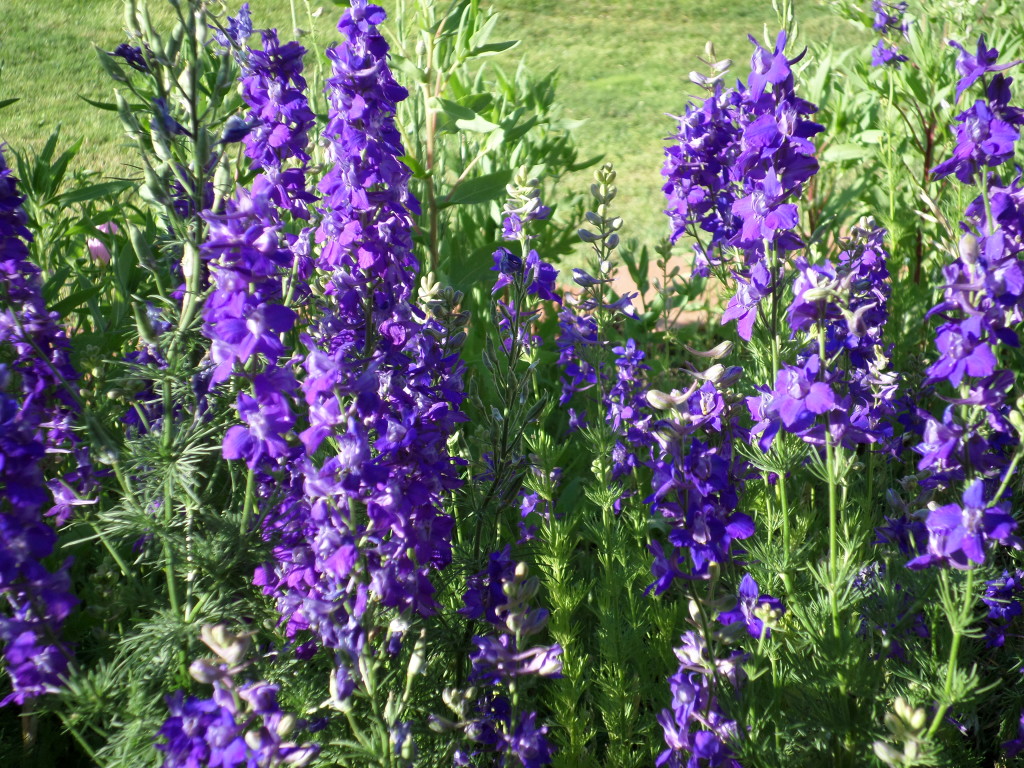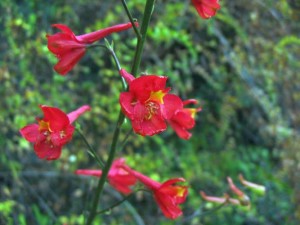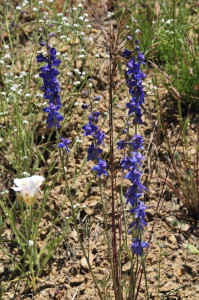Delphinium

Photo by Starlily37
A member of the buttercup family, larkspurs have distinctive flowers that are sometimes likened to orchids due to their unique shape, variety, and coloration. The name Delphinium derives from the Latin word for dolphin, referring to the shape of the flower’s nectar gland.
Delphinium species are flowering perennials, meaning they live longer than two years. Their petals range in color from fiery red and yellow to bright white to deep blues and purples. Some Delphinium species are cultivated as ornamental plants, and hybrids between different species are rather common, leading to many different larkspur varieties.
All parts of the larkspur plant are considered to be highly toxic to humans and livestock when ingested and some may cause skin irritation as well. The flowers of some Delphinium species can be crushed to produce a blue ink.
Nearly thirty different species of larkspur are found throughout California, half of which occur in the Los Padres National Forest. Three of the Delphinium species or varieties are classified as “sensitive” by the U.S. Forest Service due to their rarity.
Monterey Larkspur
Delphinium hutchinsoniae
- Sensitive – U.S. Forest Service
- Rare Plant Rank 1B.2 – California Native Plant Society
- G2 Imperiled – NatureServe (1986)
The Monterey larkspur is found within coastal Monterey County. Within the Los Padres, this larkspur can be found along the Pine Ridge Trail in Big Sur outside of Pfeiffer Big Sur State Park and near Hurricane Point. The Monterey larkspur grows in open carbonate soils of rocky and sandy slopes. Blooming from March to June, native bumble bees are the primary pollinator of this larkspur.
According to the U.S. Forest Service, threats to Monterey larkspurs include wildflower picking, road maintenance, invasive weeds, development, grazing, and road erosion. They are particularly susceptible to trampling and picking, since its habitat overlaps with popular hiking trails in the Big Sur area. Since the carbonate rocky and sandy soils on which they depend are scarce and easily disturbed, plant reestablishment can be lengthy and difficult. Larkspur habitat is also susceptible to invasion by nonnative plants such as French broom, which can overcrowd the open areas and outcompete the native plants. Three populations of Monterey larkspur in the Los Padres National Forest have been extirpated – larkspurs historically grew there but have not been seen or documented since.
Mount Pinos Larkspur
Delphinium parryi spp. purpureum
- Sensitive – U.S. Forest Service
- T4 Apparently Secure – NatureServe (2014)
The Mount Pinos larkspur grows sporadically in Kern, Santa Barbara, and Ventura counties in the understory of chaparral, scrub, and pinyon-juniper woodlands. There are ten documented occurrences in the Los Padres National Forest, from Manzana Creek, to Matilija Canyon and Upper Sespe Creek, to the San Emigdio Mountains and the Mt. Pinos region.
This larkspur, which blooms from May to June, is one of five subspecies of Delphinium parryi. It can be differentiated from other larkspur when flowering, as leaves on the bottom of the stem will still be present; usually, these “basal” leaves fall off prior to flowering for other larkspur species. The Mount Pinos larkspur prefers understory habitat of chaparral, desert scrub, and juniper woodlands.
According to the Forest Service, development and destruction of habitat is the primary threat to the Mount Pinos larkspur.
Umbrella Larkspur
Delphinium umbraculorum
- Sensitive – U.S. Forest Service
- Sensitive – Bureau of Land Management
- Rare Plant Rank 1B.3 – California Native Plant Society
- G3 Vulnerable – NatureServe (2017)
The umbrella larkspur is found at 18 locations in the Los Padres and is endemic to the Santa Lucia, San Rafael, and Santa Ynez mountain ranges as well as the Sierra Madre Ridge. It is also found on the Carrizo Plain Ecological Reserve between the Los Padres and the Carrizo Plain.
Umbrella larkspurs bloom from April to June and prefer habitats on the slopes of cismontane woodlands. This species can be differentiated by the dark blue flower and reddish color on the base of the stem. Umbrella larkspurs are threatened by livestock grazing and hybridization with other larkspur species, according to the U.S. Forest Service.
Blochman’s Larkspur
Delphinium paryii ssp. blochmaniae
- Rare Plant Rank 1B.2 – California Native Plant Society
- T2 Imperiled – NatureServe (1997)
Blochman’s larkspur is found along a narrow band of dunes and chaparral between San Luis Obispo and Santa Barbara counties. It was documented in the La Panza Range in 1997 near Castle Crags along the edge of the Machesna Mountain Wilderness. The California Native Plant Society considers this larkspur to be rare, with a moderate degree of threat. However, the Forest Service does not currently consider it to be “sensitive.”
Delphinium parryi subsp. blochmaniae is very local; no other Delphinium is normally found within its limited range. It is easily recognized by its relatively large flowers. It was named in after Ida Mae Twitchell Blochman, a famous Santa Maria teacher and botanist who collected native plants extensively in the late 1800s, several of which bear her namesake. In 1893, her plant collection was exhibited at the World’s Fair in Chicago.
Scarlet Larkspur
Delphinium cardinale
- G3 Vulnerable – NatureServe (1998)

Scarlet larkspur in bloom.
The deep red petals of the scarlet larkspur give this plant its distinctive name. It’s found extensively throughout coastal areas of southern California between Santa Barbara and San Diego, with scattered populations in San Luis Obispo and Monterey counties. In the Los Padres National Forest, it is found on rocky slopes in chaparral along Cuesta Ridge, in the San Rafael and Santa Ynez mountains, and in the Topa Topa mountains.
This tall larkspur grows on an upright stem which often exceeds two meters (~6 ft.) in height. The petals are also red, except for the top two which are scarlet-marked with bright yellow blotches. It is pollinated by hummingbirds.
Gypsum Loving Larkspur
Delphinium gypsophilum
- G4 Apparently Secure – NatureServe (2003)
The gypsum-loving larkspur has white or light pink flowers and is found throughout central California, from the coast to the Sierra. It grows up to four feet tall and is found on the fringes of the Los Padres National Forest in the Cuyama Valley, and in the Carrizo Plain National Monument. Botanists consider the plant to be moderately threatened by oil development, grazing, and road widening, but additional information is needed to fully understand the plant’s status. It is considered to be rarer than previously thought, and may be endangered.
ForestWatch works to protect these unique flowering plants wherever they are found in the Los Padres National Forest and the Carrizo Plain.







